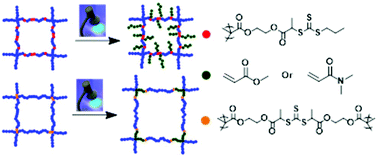Transformation of gels via catalyst-free selective RAFT photoactivation†
Abstract
This work explores the concept of structurally tailored and engineered macromolecular (STEM) networks by proposing a novel metal-free approach to prepare the networks. STEM networks are composed of polymer networks with latent initiator sites affording post-synthesis modification. The proposed approach relies on selectively activating the fragmentation of trithiocarbonate RAFT agent by relying on visible light RAFT iniferter photolysis coupled with RAFT addition–fragmentation process. The two-step synthesis explored in this work generates networks that are compositionally and mechanically differentiated than their pristine network. In addition, by careful selection of crosslinkers, conventional poly(ethylene glycol) dimethacrylate (Mn = 750) or trithiocarbonate dimethacrylate crosslinker (bis[(2-propionate)ethyl methacrylate] trithiocarbonate (bisPEMAT)), and varying concentrations of RAFT inimer (2-(2-(n-butyltrithiocarbonate)-propionate)ethyl methacrylate (BTPEMA)), three different types of primary (STEM-0) poly(methyl methacrylate) (PMMA) networks were generated under green light irradiation. These networks were then modified with methyl acrylate (MA) or N,N-dimethylacrylamide (DMA), under blue light irradiation to yield STEM-1 gels that are either stiffer or softer with different responses to polarity (hydrophilicity/hydrophobicity).



 Please wait while we load your content...
Please wait while we load your content...
